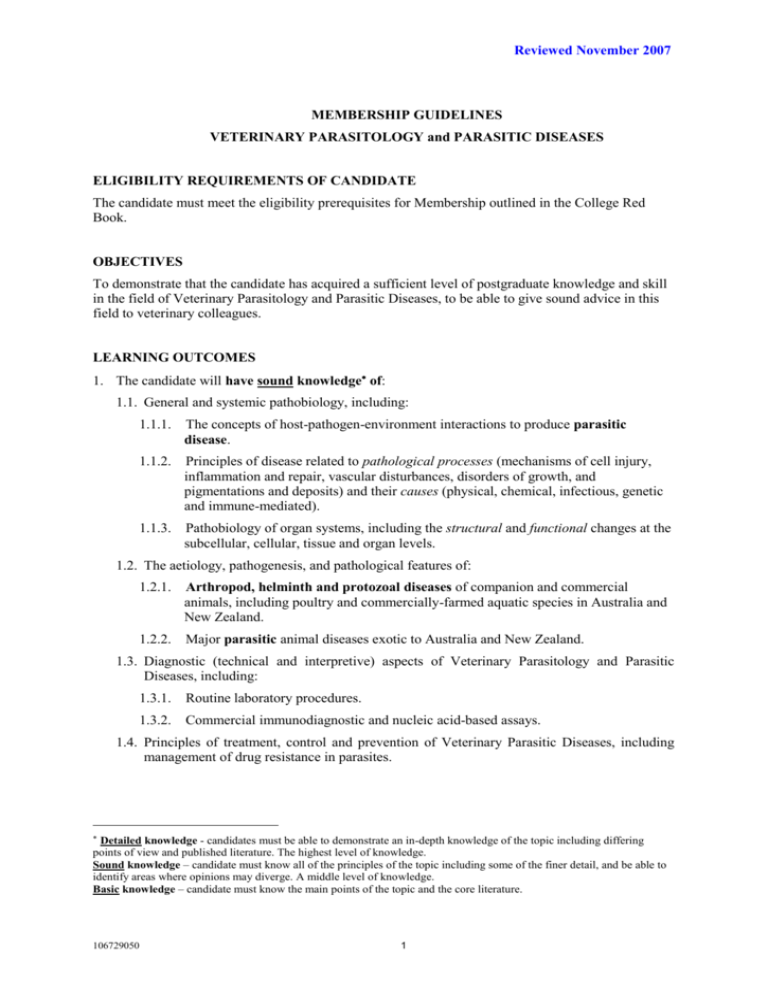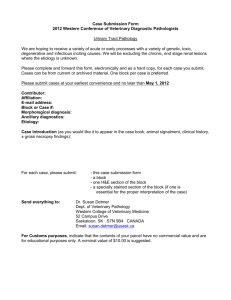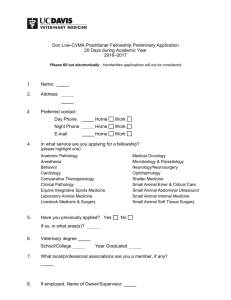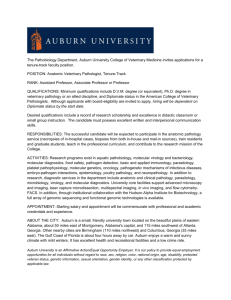Parasitology - Australian College of Veterinary Scientists
advertisement

Reviewed November 2007 MEMBERSHIP GUIDELINES VETERINARY PARASITOLOGY and PARASITIC DISEASES ELIGIBILITY REQUIREMENTS OF CANDIDATE The candidate must meet the eligibility prerequisites for Membership outlined in the College Red Book. OBJECTIVES To demonstrate that the candidate has acquired a sufficient level of postgraduate knowledge and skill in the field of Veterinary Parasitology and Parasitic Diseases, to be able to give sound advice in this field to veterinary colleagues. LEARNING OUTCOMES 1. The candidate will have sound knowledge of: 1.1. General and systemic pathobiology, including: 1.1.1. The concepts of host-pathogen-environment interactions to produce parasitic disease. 1.1.2. Principles of disease related to pathological processes (mechanisms of cell injury, inflammation and repair, vascular disturbances, disorders of growth, and pigmentations and deposits) and their causes (physical, chemical, infectious, genetic and immune-mediated). 1.1.3. Pathobiology of organ systems, including the structural and functional changes at the subcellular, cellular, tissue and organ levels. 1.2. The aetiology, pathogenesis, and pathological features of: 1.2.1. Arthropod, helminth and protozoal diseases of companion and commercial animals, including poultry and commercially-farmed aquatic species in Australia and New Zealand. 1.2.2. Major parasitic animal diseases exotic to Australia and New Zealand. 1.3. Diagnostic (technical and interpretive) aspects of Veterinary Parasitology and Parasitic Diseases, including: 1.3.1. Routine laboratory procedures. 1.3.2. Commercial immunodiagnostic and nucleic acid-based assays. 1.4. Principles of treatment, control and prevention of Veterinary Parasitic Diseases, including management of drug resistance in parasites. Detailed knowledge - candidates must be able to demonstrate an in-depth knowledge of the topic including differing points of view and published literature. The highest level of knowledge. Sound knowledge – candidate must know all of the principles of the topic including some of the finer detail, and be able to identify areas where opinions may diverge. A middle level of knowledge. Basic knowledge – candidate must know the main points of the topic and the core literature. 106729050 1 Reviewed November 2007 1.5. Parasitic zoonoses, including the parasites (endo- and ecto-) of companion and commercial animals that may infect humans, the Public Health aspects of parasitic zoonotic diseases, and the epidemiology and control of these zoonoses. 2. The candidate will have basic knowledge of: 2.1. The aetiology, pathogenesis and pathological features of: 2.1.1. Major parasitic diseases of laboratory animals, and wildlife and zoo species in Australia and New Zealand. 2.2. Diagnostic (technical and interpretive) aspects of related disciplines, including Veterinary Pathology, Veterinary Microbiology, Immunology and Toxicology, including: 2.2.1. Routine laboratory procedures. 2.3. Principles of related disciplines, including Comparative Anatomy, Physiology, Biochemistry, Veterinary Medicine, Molecular Biology (predominantly the principles of PCR and in situ hybridization), Veterinary Epidemiology, Veterinary Public Health, and Statistics. 3. The candidate will be able to: 3.1. Name, describe and identify the common internal parasites (nematodes, cestodes, trematodes, protozoans) and ectoparasites (insects, arachnids) and diagnose the internal parasitoses and ectoparasitoses of the common companion and commercial animals. 3.2. Examine faeces or urine from companion or commercial animals for parasites, using standard techniques, and identify any parasitic structures present. 3.3. Examine a blood sample from an animal and identify intra- and intercellular parasites using routine methods, including immunological tests where commercially available. 3.4. Carry out a routine necropsy on a common companion or commercial animal and, using standard methods, recover and preserve helminths present in the gastro-intestinal tract, liver or lungs, identify the parasites, and estimate the total population and percentage of individual species. 3.5. Examine an animal for ectoparasites and identify the parasites using routine methods and immunological tests where available. Know where to seek help in the identification of ectoparasites on zoo animals and wildlife. 3.6. Apply appropriate tests to identify or confirm anthelmintic resistance in helminth parasites of ruminants or horses. Based on the results of the tests and knowledge of the management system, suggest alternative control measures for farms and horse establishments. 3.7. Provide to veterinarians and non-veterinarians information and advice on parasitic infections in animals, using concise clear verbal and written communication. The College recommends the following definitions for the three levels of knowledge (detailed, sound, basic). EXAMINATIONS Refer to the Red Book Section 10. The Membership examination has two (2) sections, the Written and Practical/Oral. The Written consists of two (2) parts: 1. Written Paper 1 (2 hours – 50%) 106729050 2 Reviewed November 2007 Written Paper 1 assesses knowledge of the principles of Veterinary Parasitology and Parasitic Diseases (including disease mechanisms associated with parasites) as described in the Learning Outcomes. The candidate should be able give examples of the application of the principles of pathobiology to specific parasitic diseases of animals. The candidate should be aware of recent advances in pathobiology (as covered in recent review articles). There is some choice in this paper. 2. Written Paper 2 (2 hours – 50%) Written Paper 2 assesses the candidate’s ability to apply the principles of Veterinary Parasitology and Parasitological Diseases, with an emphasis on knowledge of the aetiology, pathogenesis, pathological features, epidemiology, diagnosis, treatment and control of parasitic diseases of animals, as described in the Learning Outcomes). Emphasis will be on domestic species and major endemic diseases, but the candidate should have knowledge of important parasitic diseases of other animal species and of major exotic parasitic diseases of animals. There is considerable choice in this paper. The Practical/Oral consists of two (2) parts: 1. Practical (2 hours - 66.6%) Practical assesses the ability to identify the common parasites of the domestic animals, and to detect, describe and interpret gross and microscopic (histological) changes in organs and tissues associated with parasitic infections. In all cases the host species and the site of infection will be given. The candidate may be required to evaluate preserved specimens and projected images. 2. Oral (1 hour - 33.3%) Oral provides the candidate with a further opportunity to demonstrate knowledge of Veterinary Parasitology and Parasitic Diseases. RECOMMENDED RESOURCES (BOOKS, JOURNALS) The candidate is expected to read widely within the discipline, paying particular attention to areas not part of their normal work experiences. This list of books and journals is intended to guide the candidate to some core references (*, **, and *** indicate the likely most important references) and other source material. Candidates also should be guided by their mentors. The list is not comprehensive and is not intended as an indicator of the content of the examination. Textbooks Parasitology Manuals prepared for undergraduate veterinary students from any of the Australian or New Zealand Veterinary Faculties. Animal Health in Australia, Australian Bureau Animal Health, Department of Primary Industry: Vol. 5: Callow IL Protozoal and Rickettsial Diseases (1984). Vol. 8: VG Cole. Helminth Parasites of Sheep and Cattle (1986). Reviews, University of Sydney, Post Graduate Committee in Veterinary Science: No 24: Prescott C. Parasitic Diseases of the Cat in Australia (1984). No.28: Arundel JH. Parasitic Diseases of the Horse. (1985). No 31: Dunsmore JD, Shaw SE. Clinical Parasitology of Dogs (1990). No 32 Smeal MG. Parasites of Cattle (1995). 106729050 3 Reviewed November 2007 Adam KMG, Paul J, Zaman V. Medical and Veterinary Protozoology, An Illustrated Guide Churchill Livingstone, Edinburgh (1971). Bowman DD, Hendrix CM, Lindsay DS, Barr SC. Feline Clinical Parasitology. Iowa State University Press, Ames, (2002) Bowman DD, Lynn RC, Eberhard ML. Georgis’ Parasitology for Veterinarians, 8th Edition. WB Saunders, St Louis (2003) Dunn AM. Veterinary Helminthology William Heinemann Medical Books Ltd, London (1978). Kassai T. Veterinary Helminthology, Butterworth-Heinemann, Oxford (1999). Kettle DS. Medical and Veterinary Entomology, 2nd Edn. CAB International, Wallingford (1995). Manual of Veterinary Parasitological Techniques Reference Book 418 Ministry of Agriculture and fisheries and Food, Her Majesty’s Stationary Office, London (1971). Roberts FR Australian Ticks CSIRO (1970). Rosskopf W, Woerpel R Diseases of Caged and Aviary Birds, 3rd Ed, Williams & Wilkins, Baltimore (1996). Saif YM et al. Section IV Parasitic Diseases in Diseases of Poultry, 11th Ed, Iowa State University Press, Ames (2003). Soulsby EJL. Helminths, Arthropods and Protozoa of Domestic Animals (7th Edition of Monnig’s Veterinary Helminthology & Entomology) Balliere, Tyndall Cassell, London (1982). Taylor MA, Coop RL, Wall RL. Veterinary Parasitology, 3rd Edition Blackwell Publishing, Oxford (2007) Thienpont D, Rochette F, Vanparijs OFJ Diagnosing Helminthiasis through Coprological Examination Jansen Research Foundation (1979). Wall R and Shearer D. Veterinary Entomology, 2nd Edn, Chapman and Hall, London (2001). Whitlock JH Diagnosis of Veterinary Parasitisms Lea & Febiger, Philadelphia (1960). Zajac AM, Conboy GA. Veterinary Clinical Parasitology 7th Blackwell Publishing, Ames (2006). General Veterinary Pathology Cheville NF Cell Pathology Iowa State University Press, Ames. Kumar, V, Abbas, AK, Fausto, N Robbins and Cotran Pathologic Basis of Disease. 7th edn. Elsevier Saunders (2005). McGavin MD, Zachary JF. Pathologic Basis of Veterinary Pathology 4th edn. Mosby, St Louis (2007). Slauson, DO, Cooper, BJ. - Mechanisms of Disease, 3rd edn. Mosby (2002). Anatomical Pathology Maxie MG editor. Jubb, Kennedy & Palmer’s Pathology of Domestic Animals, 5th edn. Elsevier. Volumes 1-3 (2007). McGavin MD, Zachary JF. Pathologic Basis of Veterinary Pathology 4th edn. Mosby, St Louis (2007). General References and Associated Disciplines Calnek BW et al Diseases of Poultry 10th edn Iowa State University Press, Iowa (1997). 106729050 4 Reviewed November 2007 Geering WA, Forman AJ, Nunn MJ. Exotic Diseases of Animals. A Field Guide for Australian Veterinarians. Australian Government Publishing Service Canberra (1995). Noga EJ. Fish Disease. Diagnosis and Treatment Mosby-Year Book Inc, Missouri. (1996) Journals (particularly of the immediate past 5 years). Int J Parasitol. Parasitol. Vet Parasitol. Vet Res. Amer J Vet Res. Aust Vet J. Aust Vet Practitioner. Comp Clin. Pathol. Comp Continuing. Education for the Practising Veterinarian. Equine Vet J. J Amer Anim Hosp Assoc. J Amer Vet Med. Assoc. J Comp Pathol. J Vet Diagn Investig. NZ Vet J. Res Vet Sci. Vet Clin Pathol. Vet Pathol. Vet Clinics N. Amer (Small Animal Practice, Equine Practice and Food Animal Practice). Vet Rec. Journals for Review Articles Trends in Parasitology. Immunology Today. New England Journal of Medicine. Websites Animal Health Australia (to access AUSVETPLAN through publications link): http://www.animalhealthaustralia.com.au/aahc/home-page.cfm Australian Society for Parasitology home page: 106729050 5 Reviewed November 2007 http://parasite.org.au/ 106729050 6







